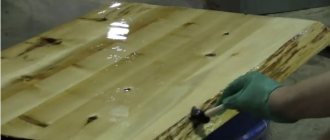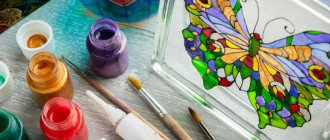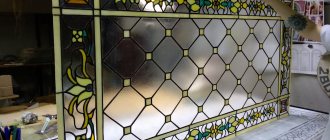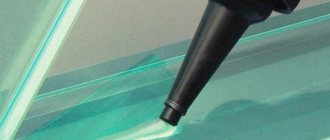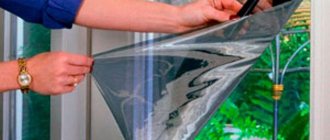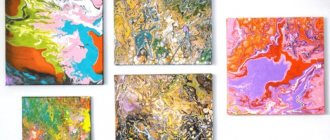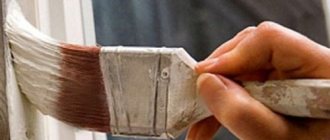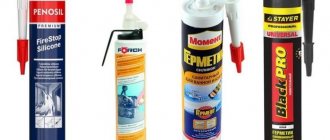Silicate paints, suspensions of pigments, fillers, hardeners and other additives in an aqueous solution of alkali metal silicates - liquid glass.
The ability of liquid glass to act as a film former is due to polycondensation. processes occurring in it in the presence of CO2 or other agents and leading to the formation of three-dimensional polymers. These polymers are not soluble. in water. have high fur. strength. good adhesion to concrete. plaster and other materials. During the aging process, silicate paints may release silicic acid gel.
Composition of silicate paints
Liquid glass is the basis of silicate paints. Sometimes organosilicon resins are added to the composition. To give paints a specific color, pigment powders made from metals (zinc, aluminum, iron, etc.) are used. Of these, aluminum and zinc also provide anti-corrosion properties. Mica, chalk, and talc are used as fillers to ensure the paint is of normal thickness. The mixture of pigments and fillers is distributed as follows: talc - 15%, chalk - 37-70%, pigments - 15-48%.
Potassium glass must be diluted with water in a ratio of 1–1.5, then a mixture of pigments and filler is introduced. This is done immediately before work, since the finished paint must be used no later than 8 hours from the date of manufacture. When using paint, it must be constantly stirred, as a sediment forms from the interaction of liquid glass, pigments and talc.
The paint should not be used at temperatures of 5°C or lower. When exposed to direct sunlight, painting is also prohibited - the paint becomes spongy, fragile and is destroyed by simple wiping.
Surface preparation
Application of the composition begins with the preparation of the car, which occurs in several stages:
- Checking the complete set of the product
. As a rule, liquid glass is sold together with fiber and towels for polishing, gloves, a sponge, and a pipette with a hardener (the last 2 components are present only in two-component compositions). Each of the components performs a specific function. Therefore, it is better not to look for a replacement among improvised means, but to buy it in a store. - Start preparing the car body
. First, you need to wash the car surface from dirt and dust with your own hands, then dry it and apply a degreaser (alcohol or white spirit diluted in water) to it. Do not use a product based on silicone or low-quality alcohol. If you previously coated the body with polish, remove it using a special paste. The presence of any film between the paintwork and liquid glass will cause a short period of use of the product. - Choose a place to work
. The best option is the garage - it is dry, warm (the optimal temperature for applying the composition is +20 degrees) and air penetrates there. Do not apply the product in an open space - dust will quickly settle on the liquid glass, ruining its appearance. Direct UV rays have a bad effect on the product.
Positive properties of silicate paints
Among other paints, they are primarily distinguished by such properties as vapor permeability at the same time as moisture resistance, which is so important especially for outdoor work. These paints are not afraid of ultraviolet radiation and low temperatures after finishing painting work. And high temperatures are not scary, since silicate paint is fireproof. Silicate paints are more durable than lime-based paints, so they are more often used on facade work. The paints are not afraid of smog and acid rain. They are biostable, as they cannot serve as a breeding ground for microorganisms, fungi and insects.
Silicate paint itself is mineral and therefore fits well on mineral surfaces: plaster, concrete, lime paint, ceramics, stone, brick. The paint forms a smooth matte surface that does not retain dust and dirt, and its smoothness allows them to be easily washed off with an ordinary damp cloth.
Technology for working with water-repellent silicate paints
Before use, silicate paints always consist of two main components: a mixture and potassium liquid glass. Paints are usually divided into two types: moisture-resistant and regular. When working with any of them, you should always follow the following sequence:
- 1. Priming the surface to be painted with a solution of potassium glass (liquid) with a density of 1.15 g/cm3;
- 2. Preparation of paint. To do this, liquid glass is diluted with water to a density of 1.17 g/cm3, the resulting mixture is thoroughly mixed with an equal weight amount of the pigment-filler mixture;
- 3. Now a water-repellent liquid (GKZh-10 or GKZh-11) is added to the already diluted solution (only for the first type), at the rate of one-fifth by weight of the finished paint;
- 4. Painting is done in two layers over two days, and on the first day its viscosity should be slightly higher. In no case is the same paint used for two days, so you need to prepare the same amount of paint as will be spent in one day.
Is it worth covering a car with nanoceramics?
The rather high cost of coverage stops many. Still, not everyone can shell out twenty thousand rubles for beauty. If you do not know how to properly apply liquid glass to a car, it is better to entrust the labor-intensive operation to professionals.
According to reviews, with proper coating, the machine can withstand up to a hundred washes. Manufacturers of polishes guarantee preservation of the original appearance for three years, but in Russian conditions the treatment must be done annually.
A significant advantage is that the car needs washing much less often. But it is advisable to wash with gentle shampoos. Also one of the decisive points is the region of residence of the car owner. In areas where rain and snowfall are rare, such coverage may not be necessary.
To find out how liquid glass is applied to a car, it is better to consult with those who have experience in using such products. Most agree that Japanese coating compounds are best. They are not cheap, but the impeccable quality and mirror shine are worth it.
One of the features of this type of polish is that the composition chemically reacts and adheres to the original paint of the car. A big plus of the treatment is that the car looks like new after it.
If the budget allows, of course, it is better to make such a coating.
Application of silicate paints
They are used for protective coating of plastered walls, concrete, ceramics, etc. Silicate paints with the addition of zinc or aluminum powder protect metals from corrosion. They paint walls like frescoes. The paints are translucent, which is why they are used to create stained glass windows. Silicate paints are used to mark the roadway. Moisture-resistant silicate paint is used for painting surfaces that often need to be washed.
More articles about paints:
Silicate paints, suspensions of pigments, fillers, hardeners and other additives in an aqueous solution of alkali metal silicates - liquid glass.
The ability of liquid glass to act as a film former is due to polycondensation. processes occurring in it in the presence of CO2 or other agents and leading to the formation of three-dimensional polymers. These polymers are not soluble. in water. have high fur. strength. good adhesion to concrete. plaster and other materials. During the aging process, silicate paints may release silicic acid gel.
Other uses
As noted above, the methods of using liquid glass are very wide. In many areas, the material has become simply irreplaceable, as it replaces other expensive types of materials, but at the same time gives them the best properties.
Dye
Types of paints that are produced on the basis of liquid glass are called silicate. They are based on sodium glass in liquid form, water as a diluent and colored tint.
In this case, there are two types of paints of this type:
- Silicate coatings that do not contain any organic components. Typically used as a coating for mineral substrates, since they are most resistant to alkali;
- Dispersion-silicate types of paints contain, in addition to the main components, a water repellent and a synthetic dispersion. Their level usually does not exceed 5%. This type of paint using liquid glass is used most often because it can be applied to a wide range of materials.
These types of paints have wide properties: water repellency, low contamination, high vapor permeability, durability, and environmental friendliness. However, it is not suitable for application to concrete surfaces, since in this case the diffusion of carbon dioxide may increase several times.
To strengthen the soil
Liquid glue is also used to carry out work to strengthen the soil. In this case, the process can be carried out either sequentially or simultaneously. In the first case, the glue is pumped into the soil, followed by a hardener. In this case, the glue is prepared from resin and liquid glass.
Thanks to liquid glass, not only strength but also water resistance increases several times, which makes it possible to create certain protection not only against ground subsidence in areas where houses are being built, but also in various pits intended for large-scale construction projects.
In addition to soil, you can also strengthen poor quality floor screed using liquid glass:
For processing other materials
In addition to the methods of using liquid glass described above, there are other materials with which it interacts well:
- Sand. Based on these two components, you can make cement or use it to build a swimming pool. The resulting mixture has very good qualities, simultaneously providing good fastening of materials to each other and protection from moisture penetration;
- Wood processing. Impregnation of floors, wooden structures, crafts - this list can be supplemented as desired. Liquid glass is perfectly capable of interacting with it, extending its service life many times over. If the floor is impregnated with it, waterproofing is additionally ensured, which means that significant savings can be made on some other materials for this purpose;
- When laying furnaces, liquid glass is used to prepare the mortar intended for masonry. It is able to withstand high temperatures, which further increases its fire resistance;
- Treatment of walls with plaster. Liquid glass is easy to apply and strengthens the protective layer of the walls, but if you plan to paint them later, it is better not to use it.
Liquid glass
Liquid potassium glass is usually used to prepare silicate paints.
K2O • mSiO2 • nH2O, where m (silica module) 9 3, n = 2-5, less often liquid glasses with cations Na+, Li+, NH+4 or its org. derivatives.
The type of glass and the composition of the composition determine the covering power and other properties of silicate paints, as well as their viability - the time during which silicate paints are suitable for use.
To obtain silicate paints use:
- alkali- and light-resistant pigments and fillers, most often Zn and Fe oxides; Al and Ti,
- hydroxides and carbonates of these metals, metal powders (Zn dust, Al powder, etc.).
Hardeners in paints
Active pigments and fillers also act as a hardener: their introduction increases the viscosity of the composition and causes curing due to interaction. surface of pigments and fillers with liquid glass or the formation of insoluble silicates. Basic active pigments – ZnO, yellow iron oxide pigment, ocher, etc., active fillers – dolomite, marshallite, alumina, etc.; their content in silicate paints is no more than 20%. Dr. possible fillers for silicate paints - expanded perlite, ground fireclay, pyrite cinders, diabase powder, glass, etc.
Curing of silicate paints occurs under the influence of water evaporation, changes in temperature or pH of the environment, in the presence of active pigments and fillers or special ones. accelerators, so-called. silicatizers, for example MgCO3, Ca borate or calcium silicates that are part of blast furnace slag.
Silicate paints are produced in double packaging: liquid potassium glass (in barrels) dense. 1.3 g/cm3 and dry part (in bags) of pigments, fillers and silicates. Prepare silicate paints immediately before use by diluting liquid glass with water until thick. 1.12-1.18 g/cm3 and introducing the dry part in a 1:1 ratio. Viability of silicate paints is approx. 12 hours. Apply silicate paints to the surface using a sprayer, brush or roller in 2-3 layers after 24 hours.
In order to improve the protective and decorative properties of coatings (water resistance, adhesion, etc.) and increase the viability of silicate paints, they are modified by introducing small amounts of aqueous dispersions of polymers (acrylic, styrene-butadiene, etc.).
Table. Preparation of facade surfaces for painting with silicate and silicone paint and varnish systems.
| Types of facade surfaces | Preparation for priming | Primer |
| 1 | 2 | 3 |
| 1. Concrete | Not subject to puttying. Defects (chips, holes, cracks, unevenness) should be eliminated by grinding with a polymer cement solution. Remove traces of grease and grease. Clean off efflorescence with a brush. Rinse the sanding surfaces with a jet of water under pressure. Treat mirror surfaces with wet sandblasting or sanding. Dry to a moisture content of no more than 4%. | Apply a primer to dense, durable, non-chalking concrete. Apply a deep-penetrating impregnation to porous, shallow, lightweight concrete, and a day later - a primer. |
| 2. Plastered with ordinary plaster | New plaster must be painted no earlier than 4 weeks after it is completed (humidity no more than 8%). When repairing old plaster: | Apply primer to new dense, durable cement-sand plaster. Apply a deep-penetrating impregnation to new lime-cement, repaired, unevenly absorbent, porous, sand-covered plasters until completely absorbed, and then a primer after 24 hours. Prime the putty areas again. |
| – remove weak areas, open cracks; | ||
| – restoration should be carried out with a solution similar in composition and strength; | ||
| – grind off the sagging, align the depressions into a common plane; | ||
| – leave repaired areas for at least 7 days. | ||
| Before painting, wash and dry the plaster. | ||
| 3. Plastered with decorative (terrasite and stone-like) plasters | Decorative plaster must be painted if there is a high degree of destruction. Repair of terrasite plaster should be carried out using terrasite mortar to match the existing one. Repair of stone-like plaster should be carried out with a solution similar in composition, strength and color to the undamaged areas of the plaster. Treat the repaired areas to match the texture of the existing plaster. Wash and dry before painting. | Prime the terrazite plaster with a deeply penetrating impregnation, and then a day later with a primer. Apply primer to stone-like plasters. |
| 4. Plastering old architectural monument buildings | Repair of plaster should be carried out in accordance with the restoration project. Compensate for losses with a solution similar to the original one. Grind the entire surface with a selected solution. Dry to a moisture content of no more than 8%. | Impregnate the plaster with deeply penetrating impregnation until completely saturated. If necessary, level the surfaces with putty. Apply primer. |
| 5. Plastered areas of loss of cladding made of ceramic tiles, blocks, bricks | Places with lost cladding should be plastered using cement-sand mortar M-100 with jointing for the cladding and processed to match its texture. Dry to a moisture content of no more than 8%. Painting plastered areas with silicate and silicone paint is recommended when repairing cladding made of large-sized ceramic tiles and blocks. | Impregnate the plaster with primer. After a day - paint individually with colors that differ by 2 - 3 tones. |
| 6. Sand-lime brick | Repair places where brick surfaces are damaged and fill empty joints with lime-cement mortar M-100. Wash and dry the facade. | Impregnate the sand-lime brickwork with a deeply penetrating impregnation. After a day, apply primer. |
| 7. Red brick | Fill the joints with lime-cement mortar M-100. Repair damaged brick surfaces with polymer cement mortar. Clean off efflorescence with brushes. | Impregnate weak, weathered brick surfaces with a deeply penetrating impregnation. After a day, apply a primer to the entire surface of the masonry. |
| 8. Painted facades | To paint with silicate paint, completely remove the paint layers, since silicate paints are not compatible with other paints. Remove old silicate paint with brushes and rinse with water. To paint with silicone paints, remove weak, non-load-bearing, cracked, peeling, and chalking old paint layers. Removal should be carried out mechanically, by cleaning with hot water under pressure or with chemical washes. Old paint layers with load-bearing capacity should be washed and glossy coatings should be sanded. | When painting with silicate paints, apply deep penetrating impregnation to surfaces cleaned of old deposits, level the surfaces with putty and prime. When painting with silicone paints, apply deep-penetrating impregnation only to weak, shallow or cleaned bases of old layers. Level the surfaces with putty and prime. |
